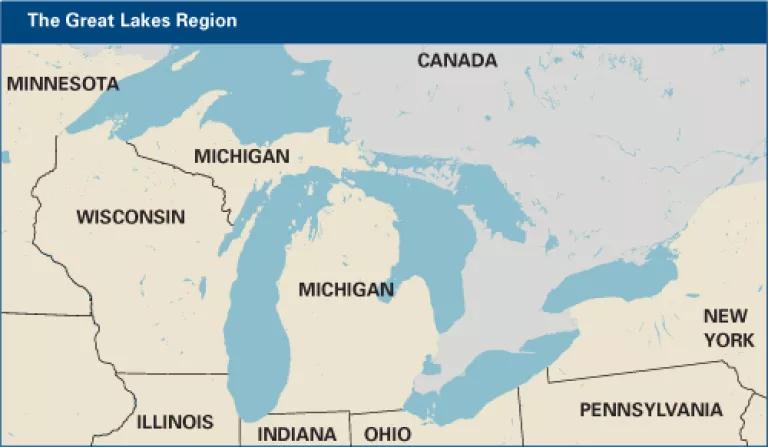Mark Twain famously said, “whiskey’s for drinking; water’s for fighting about.” My guess is that we drink more beer in the Great Lakes than whiskey, but we certainly know about fighting to protect our source of drinking water and the economic engine that drives millions of jobs and provides untold recreation opportunities.

The Great Lakes-St. Lawrence River Basin Water Resources Compact was supposed to prevent fights over how the Basin waters are managed, but, as a new report from NRDC shows, the states’ slow progress in implementing the Compact may mean additional fights are on the horizon.
The Compact, signed into federal law in 2008, resulted from years of hard work and tough negotiations by 8 Great Lakes States, 2 Canadian provinces and the governments of the U.S. and Canada. The Compact has two primary purposes: to prevent the diversion of Great Lakes and St. Lawrence waters outside of the Basin, and to efficiently manage the withdrawal and use of water within the Basin.
Our report finds that states are moving slowly – at best -- to meet the water conservation and efficiency requirements of the Compact. States are in a tough position, to be sure – the impacts of the recession on state budgets, resources and morale can’t be underestimated. Six of the 8 Great Lakes Governors were elected in November 2010 and new governors naturally bring new agendas and priorities. New York’s Governor Cuomo is the 3rd person to hold that office since the Compact was signed by President Bush. But, tough times don’t excuse the states from their legal responsibilities – and the Compact is a legally binding agreement. There’s no “Get Out of the Compact Free” card if the economy tanks or a new governor is elected.
To be clear, the Compact’s promise goes beyond its legally binding nature – it’s an aspirational view of how the waters of the Great Lakes can be most effectively managed to protect the environment and support economic development.
So, are we meeting those lofty aspirations?
There have been two reporting deadlines – the first, in December, 2009, required the states to report on existing programs and regulations. Each state met this deadline (the Council of Great Lakes Governors serves as the Secretariat to the Compact Council; you can read their reviews of the state reports here).
The next deadline -- December 8, 2010 – proved much more difficult to meet. Each state was supposed to do three things: adapt the regional water conservation goals and objectives to reflect state-specific activitie and priorities; develop water conservation and efficiency programs based on the state goals and objectives; and commit to promote environmentally sound and economically feasible conservation measures.
We found that no state fully met those milestones, although Wisconsin came closest. Other states, including Illinois, Ohio, Minnesota and Michigan, met part of the milestones. By December 8, 2011, states must report on how the implementation of the 3 requirements is going. At this point, the states are in a hole, getting further and further behind with every month – they can’t report on the implementation of something that doesn’t exist.
Blown deadlines aside, it’s not all bad news here. The report also makes clear that there’s a lot of good work going on across the Basin – and, just as importantly, there are common sense water conservation and efficiency strategies the states and water utilities can undertake to make better use of scarce resources – both water and money (more on those measures in a future blog).
Implementation of the Compact, like the water it seeks to govern, is fluid.
Consider New York -- with the passage of landmark water withdrawal legislation last week (my colleague, Eric Goldstein, blogged on what the legislative victory means) the state is poised to seize the leadership mantle on innovative water conservation and efficiency programs. The landmark water withdrawal legislation creates a comprehensive framework for compliance and New York can draw from many programs, including its innovative integration of green infrastructure strategies into State Revolving Fund guidelines, to develop a water conservation and efficiency program that could serve as a model for the Basin. It can also draw on the work of its own Advisory Council.
On the other side of the Basin, Wisconsin has shown real leadership in its implementation of the Compact to date. But, Wisconsin will face the first serious test of the Compact – the City of Waukesha will likely be the first city outside of the Basin to request a diversion. Will the Wisconsin Department of Natural Resources (DNR) continue to review that proposal in the thoughtful and methodical way it’s done to date, or will politics take over?
We’re at the halfway point of Compact implementation and it’s clear that the whole thing can go either way. The Great Lakes advocacy community is a pretty positive bunch of folks. We all tend to stick to the positive. With that in mind, I have high hopes that the states will get their acts together to fully realize the promise of the Compact. A lot of organizations, including NRDC, the National Wildlife Federation, the Alliance for the Great Lakes, are prepared to help states do that.
But we also have to be realisitic. There is a real possibility that this thing can go off the rails if politics overtakes policy in places like Waukesha or the State House in Columbus. Legally-binding or not, the public who so clearly loves our magical inland waters must hold their Governors’ feet to the fire to make sure the Compact moves from strong words to stronger actions.
Otherwise, we’ll all need to prepare ourselves for the fights ahead.




